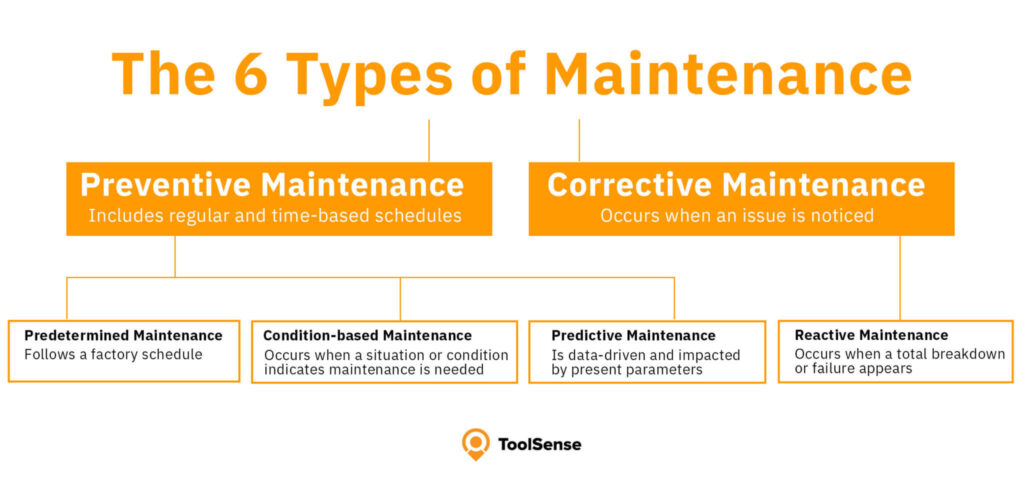Equipment failure is a costly headache for any business. Unscheduled downtime, expensive repairs, and decreased productivity can all impact your bottom line. A well-defined maintenance strategy is crucial for minimizing these risks and ensuring your equipment operates efficiently and reliably. But with so many different approaches available, how do you choose the right one for your specific needs?

Key Takeaways:
- Effective maintenance strategies minimize downtime, reduce repair costs, and extend equipment lifespan.
- Choosing the right strategy depends on factors like equipment criticality, budget constraints, and risk tolerance.
- Different strategies include reactive, preventative, predictive, and reliability-centered maintenance.
- Implementing a Computerized Maintenance Management System (CMMS) can greatly improve maintenance efficiency.
Understanding Reactive Maintenance Strategy
Reactive maintenance, also known as “run-to-failure” maintenance, is exactly what it sounds like: you wait until a piece of equipment breaks down before taking action. While this approach might seem appealing in its simplicity and initial cost savings, it’s often the most expensive in the long run. Unplanned downtime can disrupt operations, lead to production losses, and even create safety hazards.
Reactive maintenance is generally only suitable for equipment that is non-critical, inexpensive to repair or replace, and doesn’t significantly impact overall operations when it fails. For example, a lightbulb in a low-traffic area might be a good candidate for reactive maintenance. However, relying solely on reactive maintenance for critical equipment is a risky proposition that can lead to major headaches down the road. Imagine a vital server going down unexpectedly, causing widespread disruption and data loss. The cost of such a failure far outweighs any potential savings from delaying maintenance.
Implementing Preventative Maintenance Strategy
Preventative maintenance involves performing maintenance tasks at predetermined intervals, regardless of the equipment’s condition. This proactive approach aims to prevent breakdowns before they occur by addressing potential issues early on. Common preventative maintenance tasks include lubrication, cleaning, inspection, and replacement of worn parts.
The key benefit of preventative maintenance is reduced downtime. By regularly servicing equipment, you can identify and fix potential problems before they lead to failures. This leads to increased equipment reliability, improved performance, and a longer lifespan. Preventative maintenance is particularly effective for equipment that experiences predictable wear and tear, or equipment for which failure would have significant consequences.
However, preventative maintenance isn’t without its drawbacks. It can be time-consuming and require significant resources, and it can lead to unnecessary maintenance if tasks are performed too frequently. It’s crucial to strike a balance between preventative maintenance and other maintenance strategies to optimize efficiency and cost-effectiveness. A well-defined preventative maintenance schedule, based on manufacturer recommendations and historical data, is essential for success. This could be something as simple as creating a recurring event in your calendar with associated tasks and reminders, or something more advanced where data can be monitored via remote sensors or through a CMMS system.
Leveraging Predictive Maintenance Strategy
Predictive maintenance takes preventative maintenance a step further by using data and technology to predict when equipment failure is likely to occur. This approach involves monitoring equipment condition using various techniques, such as vibration analysis, infrared thermography, oil analysis, and ultrasonic testing. By analyzing this data, you can identify early warning signs of potential problems and schedule maintenance only when it’s truly needed.
Predictive maintenance offers several advantages over preventative maintenance. It reduces the risk of unnecessary maintenance, minimizes downtime, and maximizes equipment lifespan. It also allows you to prioritize maintenance tasks based on the actual condition of the equipment, rather than relying on fixed schedules. However, predictive maintenance requires a significant investment in technology and training, and it may not be suitable for all types of equipment. It also requires skilled technicians who can interpret the data and make informed decisions about maintenance needs. The initial costs can be high, but the payback in reduced downtime and repair costs can be substantial, especially for critical equipment. The amount of historical data and the sophistication of the CMMS is vital to this implementation. For instance, a 100 gb database will perform better with predictive models that a 10 gb one.
Optimizing with Reliability-Centered Maintenance Strategy
Reliability-Centered Maintenance (RCM) is a systematic approach to developing a maintenance strategy that focuses on maintaining the functions of physical assets. It involves analyzing the potential failure modes of each asset and determining the most effective maintenance tasks to prevent or mitigate those failures. RCM considers factors such as safety, environmental impact, and operational consequences when developing a maintenance plan.
The RCM process typically involves identifying critical assets, analyzing their functions, identifying potential failure modes, evaluating the consequences of those failures, and selecting the most appropriate maintenance tasks. These tasks can include preventative maintenance, predictive maintenance, reactive maintenance, or even redesigning the equipment. RCM is a complex and time-consuming process, but it can lead to significant improvements in equipment reliability and reduced maintenance costs. It is especially helpful if you can measure performance of existing maintenance routines using a dashboard in your CMMS.
Choosing the right maintenance strategy is a critical decision that can significantly impact your bottom line. By carefully considering your equipment needs, budget constraints, and risk tolerance, you can develop a maintenance plan that optimizes performance, minimizes downtime, and extends equipment lifespan.



